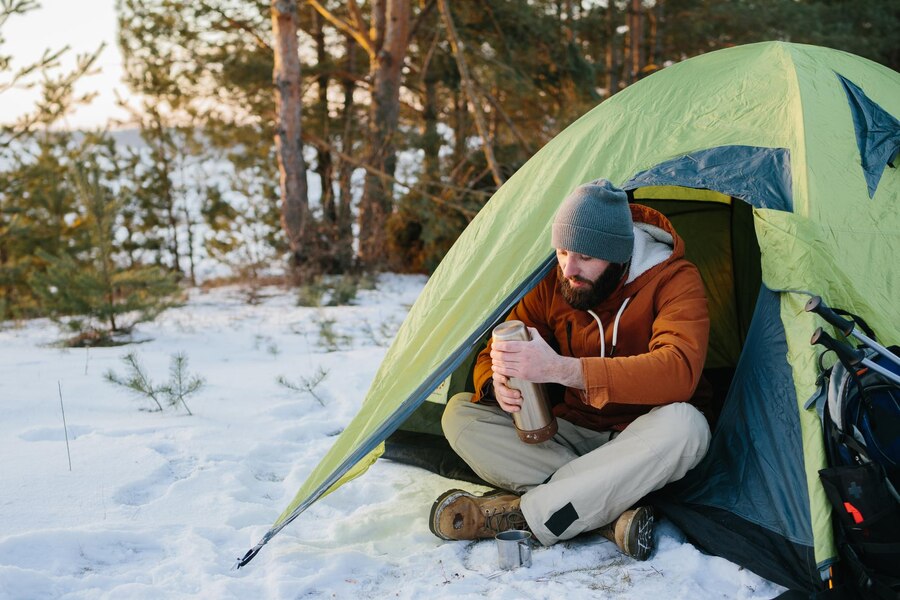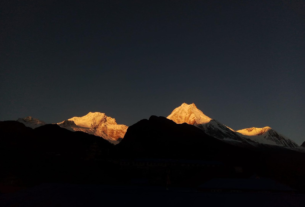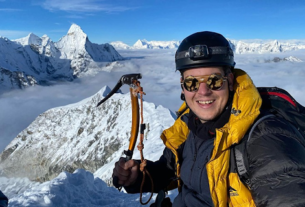The camper can experience nature in probably the most virgin and calm state through winter camping. One can always appreciate the snow-clad landscapes, crisp atmosphere, and the solitude of the season, which is a jackpot for outdoor enthusiasts.
This further comes with challenges regarding freezing temperatures, reduced daylight, and specialized gear; proper preparation will go a long way in enabling one to enjoy this experience safely. It gives you the crucial tips on gear, safety, and planning that you’ll need to make a winter camping trip successful.
Winter Camping Gear Essentials
Layering and clothing are a good way of building a warm defense. Your clothing is your primary protection against the cold, and proper layering is essential to:
- Base Layer: The base layer should be made of a material fitted to draw away sweat from your skin. It may be merino wool or a synthetic material.
- Middle layer: Fleece or down jacket insulation layers that help retain body heat.
- Outer Layer: Waterproof and windproof jackets and pants help protect against snow and winds.
- Accessories should be remembered: a pair of insulated gloves or mittens, thick wool socks, and hats that cover your ears. Scarves or balaclavas may also protect your face from windburn and frostbite.
Don’t forget accessories such as insulated gloves or mittens, thick wool socks, and hats that cover your ears. Scarves or balaclavas can provide added protection for your face, preventing windburn and frostbite.
When selecting gear, consider the environmental impact of your choices. Many waterproof garments contain PFAS (per- and polyfluoroalkyl substances), harmful chemicals linked to environmental and health concerns. Product liability lawsuits against manufacturers of PFAS highlights the risks associated with these substances. To reduce your impact and ensure safety, look for sustainable, PFAS-free alternatives.
Sleeping Bags and Pads: Sleeping Warm
A good night’s sleep in the cold depends on getting the proper sleeping setup:
- Sleeping Bags: Bring a cold-rated sleeping bag, such as one that is down for lightness and compressibility or synthetic for wet conditions.
- Sleeping Pads: These are insulated foam or air sleeping pads to help create a barrier between your body and the freezing ground. Double up sleeping pads for more warmth, or look for a pad with a high R-value.
- Pro Tip: Put a hot water bottle in your sleeping bag for a warm night.
Shelter: The Right Tent for Winter Conditions
Choosing the right shelter is critical for winter camping. Four-season tents are specifically designed for harsh conditions, featuring heavier frames and thicker fabrics to withstand heavy snow and strong winds.
When setting up camp, pick a site shielded from the wind and away from slopes prone to avalanches. Brush away snow to create a solid foundation for your tent, and consider using a tarp for additional insulation or as a cooking shelter.
Cooking Gear and Fuel: Eating Your Way Through the Cold
Cooking in freezing temperatures requires specialized equipment and techniques.
Liquid-fuel stoves are more reliable in the cold than canister stoves. To keep fuel functional, store canisters in insulated bags or carry them close to your body during the day to prevent freezing.
For hydration, use insulated water bottles or covers to stop water from freezing. Snow can be melted as a water source, but always boil it to ensure safety before drinking.
Winter-Specific Accessories
Give yourself equipment for getting around in snowy and icy conditions:
- Traction Devices: Gaiters, crampons, and microspikes improve traction on snow and ice.
- Safety Equipment: Though less essential, an ice axe and trekking poles may be employed for extra stability. A shovel should be brought in case of snow-related hazards.
- Lightings: Bring one small headlamp and additional batteries. Cold temperature saps batteries quickly.
Safety Winter Camping Tips
Cold is your worst enemy, so learn to recognize and avoid its dangers:
- Hypothermia and Frostbite: Monitor symptoms, which include shivering, numbness, or discolored skin. Dress in layers appropriate to protect extremities.
- Stay Dry: Wet clothes can quickly cause hypothermia. Waterproof bags must be carried to store extra clothes and other items.
Campground Fire Safety and Management of Heat
A campfire may be very soothing and can warm up, but not every time in winter:
- Fire Building: Learn techniques for constructing a campfire on snow or wet ground and observe local burning restrictions.
- Tent Heating Alternatives: Portable heaters or heat warmers are lifesavers, but let proper ventilation avoid carbon monoxide poisoning.
Navigation and Hazard Avoidance
Winter landscapes can be both breathtaking and treacherous, requiring careful planning and attention to safety.
Avalanche zones should be avoided by steering clear of steep slopes and learning to identify unstable snow conditions. When crossing frozen lakes and rivers, always test the ice for thickness—it should be at least 4 inches thick to safely support a person.
Planning for Emergencies
Plan a route and bring navigation tools, such as a map, compass, or GPS, in case you get lost during extreme weather. Winter camping also requires the preparation of an emergency outfit:
- First-aid kit: Include cold-weather injury supplies, frostbite, and hypothermia treatments.
- Extra Supplies: Bring extra food, clothes, and equipment if delays or conditions are Worse than expected.
- Communication Devices: Satellite phones or personal locator beacons are musts in places that don’t have cell service.
Winter Weather Considerations
Understanding and planning for winter weather conditions is crucial:
Monitor the forecasts closely both before your trip and during your stay. Learn to recognize the approach of a storm, including a temperature that drops sharply or a change in wind direction.
Coping with Shorter Days
With fewer hours of daylight, management of time is critical:
Plan to set up camp and cook meals while it’s still light. Use reflective markers and lanterns to locate your campsite in dark conditions.
Environmental and Sustainability Consideration
Special attention during winter camping minimizes environmental impacts:
- Waste Disposal: Pack all waste, including biodegradable items, in freezing conditions.
- Protection of Wildlife: Do not disturb the animals; strangely enough, some hibernate, and others conserve energy during the winter.
- Environmentally friendly equipment: When selecting gear, consider using equipment that minimizes harm to the environment. Look for products made from sustainable materials and avoid those that may release harmful chemicals, such as certain waterproofing agents or synthetic treatments. Taking these precautions helps ensure that winter landscapes remain pristine for future adventurers.
Conclusion
Winter camping offers a chance to reconnect with nature during its quietest time. You can fully enjoy this time by gearing up with the right equipment, learning safety skills, and making emergency plans. Be gentle with nature, accept the challenges, and prepare for lifetime experiences in the white, snowy wilderness. With the tips above, you will be on the road to a safe and successful winter camping experience.




